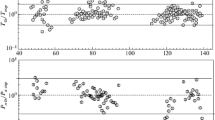Summary
A general method is presented for eliminating, in the theoretical values of the first-forbidden beta-transitions, the unphysical effects due to the particle number fluctuation allowed by the usual BCS wave functions. Analytical expressions are given for the pertinent pairing correlation reduction factors, calculated with both BCS and strict particle-number-projected BCS wave functions. Our treatment allows for the fact that parent and daughter nuclei do not have, generally, the same axial deformation. Furthermore, the blocking effect has been exactly and systematically taken into account. Numerical calculations were performed with a wrought newly adopted Nilsson model, and compared to a computation of experimental data on odd-mass nuclei from the rare-earth region. In the majority of the beta-decays studied the elimination of the unphysical components in the wave functions improves the theoretical half-lives. The influence of the Coriolis interaction has been studied in the first-order perturbation theory, and it has been found that in general it worsens theft values.
Riassunto
Si presenta un metodo generale per eliminare, nei valori teorici delle transizioni beta prime proibite, gli effetti non fisici dovuti alla fluttuazione del numero di particelle permesse dalle usuali funzioni d’onda di BCS. Si danno espressioni analitiche per i pertinenti fattori di riduzione della correlazione di accoppiamento, calcolati sia con le funzioni d’onda di BCS sia con le funzioni d’onda di BCS strette proiettate dal numero di particelle. Il nostro trattamento tien conto del fatto che il nucleo genitore e quello figlio non hanno, in generale, la stessa deformazione assiale. Infatti si è tenuto conto esattamente e sistematicamente dell’effetto di bloccaggio. Si sono eseguiti i calcoli numerici con un modello di Nilsson elaborato adottato recentemente, e si sono confrontati con un computo dei dati sperimentali sui nuclei di massa dispari della regione delle terre rare. Nella maggioranza dei decadimenti beta studiati l’eliminazione dei componenti non fisici nelle funzioni d’onda migliora le vite medie teoriche. Si è studiata l’influenza dell’interazione di Coriolis nella teoria delle perturbazioni di primo ordine, e si è trovato che essa in generale peggiora i valori dift.
Реэюме
Предлагается обший метод для исключения иэ теоретических величин однократно эапрешенных бета-переходов нефиэических зффектов, обусловленных флуктуацией числа частиц, допускаемой обычными ВСS волновыми функциями. Приводятся аналитические выражения для факторов ослабления соответствуюших парных корреляций. Наще рассмотрение учитывает тот факт, что исходное и дочернее ядра, вообше говоря, не обладают одинаковой аксиальной деформацией. Кроме того, систематически и точно учитывается зффект блокировки. Проводятся численные расчеты с помошью недавно предложенной модели Нильссона. Реэультаты вычислений сравниваются с зкспериментальными данными для ядер с нечетным массовым числом иэ области редко эемельных злементов. В больщинстве рассмотренных бета-распадов исключение нефиэических компонент в волновых функциях улучщает теоретические эначения времен жиэни. В первом приближении теории воэмушений исследуется вэаимодействие Кориолиса и обнаружено, что, вообше говоря, зто вэаимодействие ухудщаетft величины.
Similar content being viewed by others
Literatur
T. Kotani:Phys. Rev.,114, 795 (1959).
D. Bogdan:Nucl. Phys.,61, 241 (1965).
M. Sakai andS. Yoshida:Nucl. Phys.,50, 497 (1964).
L. S. Kisslinger andR. A. Sorensen:Rev. Mod. Phys.,35, 853 (1963).
I. Hamamoto:Nucl. Phys.,62, 49 (1965).
Z. M. Matumoto andM. Yamada:Prog. Theor. Phys.,19, 285 (1958).
E. S. Hernandez, L. Szybisz andA. Plastino:Zeits. Phys.,263, 401 (1973).
D. Bogdan, Tr. Cretu andG. Macarie:Zeits. Phys.,265, 385 (1973).
D. Bogdan, Tr. Cretu, G. Macarie andM. I. Chernej:Zeits. Phys.,263, 121 (1973).
M. Fellah, T. F. Hammann andD. E. Medjadi:Phys. Rev. C,8, 1585 (1973).
A. F. Miranda andM. A. Preston:Nucl. Phys.,44, 529 (1963).
M. Fellah andT. F. Hammann:Phys. Rev. C,10, 284 (1974).
S. G. Nilsson, C. F. Tsang, A. Sobiczewski, Z. Szymanski, S. Wycech, C. Gustafson, I.-L. Lamm, P. Möller andB. Nilsson:Nucl. Phys.,131 A, 1 (1969).
V. N. Fomenko:J. Phys. A,3, 8 (1970).
A. K. Kerman, R. D. Lawson andM. H. Macfarlane:Phys. Rev.,124, 162 (1961).
K. Dietrich, H. J. Mang andJ. Pradal:Phys. Rev.,135, B 22 (1964);H. J. Mang, J. O. Rasmussen andM. Rho:Phys. Rev.,141, 941 (1966).
M. E. Bunker andC. W. Reich:Rev. Mod. Phys.,43, 348 (1971).
Author information
Authors and Affiliations
Rights and permissions
About this article
Cite this article
Fellah, M., Hammann, T.F. The spurious effects of the dispersion in the number of particles on β-transitions. Nuov Cim A 30, 239–269 (1975). https://doi.org/10.1007/BF02730172
Received:
Published:
Issue Date:
DOI: https://doi.org/10.1007/BF02730172




